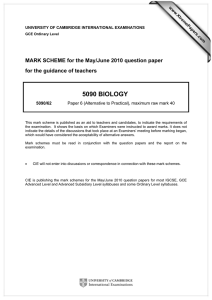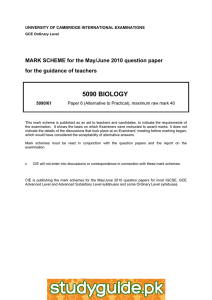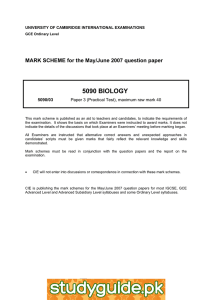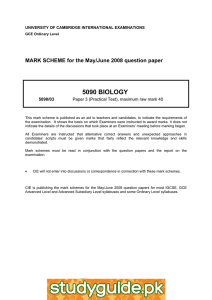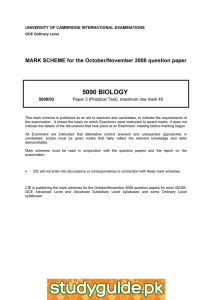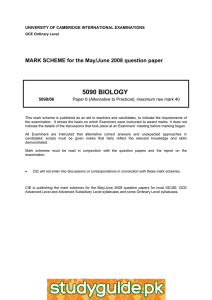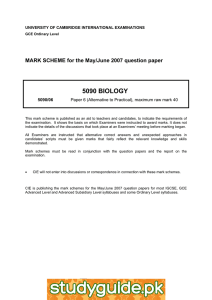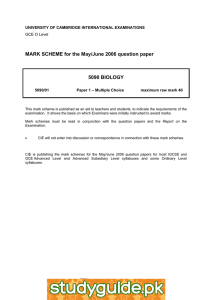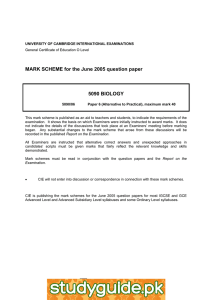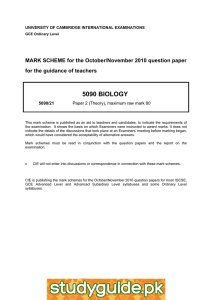5090 BIOLOGY MARK SCHEME for the May/June 2010 question paper
advertisement
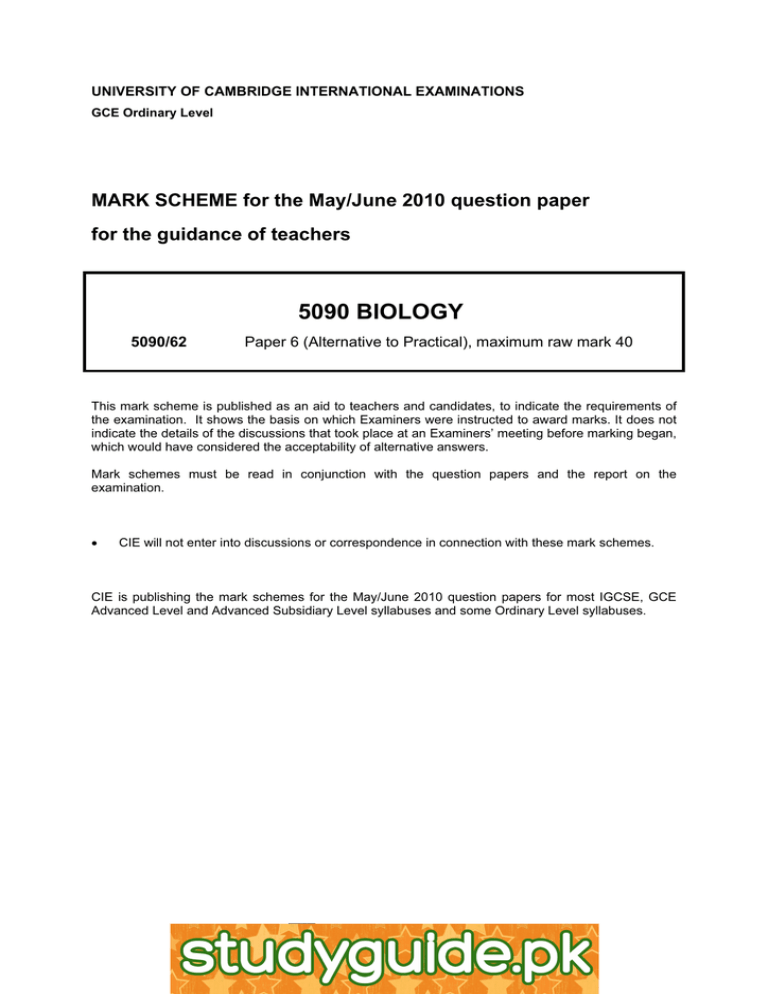
UNIVERSITY OF CAMBRIDGE INTERNATIONAL EXAMINATIONS GCE Ordinary Level MARK SCHEME for the May/June 2010 question paper for the guidance of teachers 5090 BIOLOGY 5090/62 Paper 6 (Alternative to Practical), maximum raw mark 40 This mark scheme is published as an aid to teachers and candidates, to indicate the requirements of the examination. It shows the basis on which Examiners were instructed to award marks. It does not indicate the details of the discussions that took place at an Examiners’ meeting before marking began, which would have considered the acceptability of alternative answers. Mark schemes must be read in conjunction with the question papers and the report on the examination. • CIE will not enter into discussions or correspondence in connection with these mark schemes. CIE is publishing the mark schemes for the May/June 2010 question papers for most IGCSE, GCE Advanced Level and Advanced Subsidiary Level syllabuses and some Ordinary Level syllabuses. www.XtremePapers.net Page 2 1 (a) Mark Scheme: Teachers’ version GCE O LEVEL – May/June 2010 Syllabus 5090 (i) drawing marks: 1. appropriate and realistic subject ; 2. clear, at least 6 cm, good proportion of style to ovary ; 3. 6–8 ovules shown, attached ; Paper 62 [3 max] labels: stigma ; style ; ovule ; if e.g. stamen drawn instead – no marks for drawing but allow a correct label mark [2 max] (ii) insect/bee pollination ; insect brushes anther/stamen, AW ; pollen carried/adheres to insect ; pollen to stigma ; (b) diagram marks: overall quality of attempt with at least 2 good labels ; pollen tube growing down style ; (no label required) R if grain in or down tube entry to ovule through micropyle, at base ; (no label required) male and female nuclei shown/labelled ; diploid zygote (labelled)/nuclei fuse ; (c) 2 from: calyx/sepal ; placenta; funicle ; pericarp (epicarp) ; loculus ; (ignore: remains of style/stigma) [3 max] [3 max] [2] (d) using edible parts only (seeds v whole fruit)/test both samples ; equal/known/measured masses/samples/amounts ; after drying ; equal volumes of water in test-tube ; ignite sample and heat under test-tube of water ; note increase in temperature of water ; after complete combustion ; replication/mean/average calculation described/compare rise in temp ; [5 max] plus a safety factor: e.g. goggles/lab coat (apron)/use of protective mat/gloves, etc ; [1] [Total: 19] © UCLES 2010 www.XtremePapers.net Page 3 2 Mark Scheme: Teachers’ version GCE O LEVEL – May/June 2010 Syllabus 5090 (a) attached/free ; (b) Paper 62 [1] (i) independent of gender/sex ; not related to age ; more free (than attached) ; discontinuous variation ; [2 max] (ii) 87/28 ; 3.1 = (ratio) ; [2 max] (iii) mendelian/monohybrid/genetic ratio/single gene/heterozygous parents ; free/unattached is dominant (allele) (or converse for attached) ; [2] [Total: 7] 3 (a) (i) universal indicator (liquid or paper)/pH meter or probe ; [1] (ii) (viscosity) – dropping time (from burette) ; of known volume/amount of yoghurt mixture ; or dropping measured volume onto (glass) plate ; measure diameter ; or dropping metal bearing in column of mixture ; timing fall ; or AVP ; ; [2] (b) factor, with explanation (independent), 2 from: temperature ; collisions between enzyme and substrate/staying within active range/ref. effect on (rate of) bacterial activity * ; volume of milk; substrate availability/ref. effect on (rate of) bacterial activity* ; volume of (starter culture of) bacteria ; ref. effect on (rate of) bacterial activity ; same type/source of milk ; oxygenation/aeration/stirring/mixing ; ref. effect on (rate of) bacterial activity* ; sterile, AW ; prevents pollution by ‘wrong’ bacteria ; * effect only once. AVP ; ; [4] (c) graph marks: 1. x-axis labelled ‘time/hours’ and numbered (0–5) ; 2. y-axis labelled ‘pH’ and numbered. Correct origin ; 3. all 5 points clearly and accurately plotted ; 4. smooth line of best fit or ruled connections ; reversed axes – lose marking points 1 or 2 R single straight line curve R 4. if extrapolated down to 0 bar chart: 1 and 2 only (but if reversed = 0) © UCLES 2010 www.XtremePapers.net [4] Page 4 Mark Scheme: Teachers’ version GCE O LEVEL – May/June 2010 Syllabus 5090 Paper 62 (d) pH continues to fall/more acidic ; (more) bacteria produce more (lactic) acid ; more firmly set ; as more acid increases yoghurt formation ; ref. lactose used up ; so no further change/yoghurt production complete/constant pH/bacterial activity ceases ; OVP ; [3 max] [Total: 14] © UCLES 2010 www.XtremePapers.net
